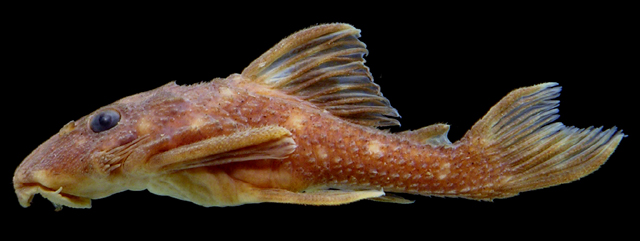| Loricariidae (Armored catfishes), subfamily: Hypostominae |
| 4.22 cm SL (male/unsexed) |
|
demersal; freshwater |
| South America: Venezuela, Amazonas State. Known only from the lower Ventuari River and the Orinoco River near its confluence with the Ventuari (Ref. 87303). |
|
Micracanthicus vandragti can be distinguished from all other Ancistrini except Hypancistrus and Spectracanthicus by having dentary teeth with longer shafts and larger cusps than premaxillary teeth; from all other Ancistrini except Megalancistrus, Acanthicus, and Panaque (Panaque) by having an enlarged gas bladder and bladder capsule whose posterior margin reaches the expanded rib of the sixth vertebral centrum and whose laterodorsal wall, the compound pterotic, bulges dorsally forming a slight convexity visible externally, with relatively large fenestrae concentrated ventrally; from all other Ancistrini except Hypancistrus, Panaque, Peckoltia, Parancistrus, Exastilithoxus, Lithoxus, Leporacanthicus, Megalancistrus, Pseudacanthicus, and Spectracanthicus by having dentaries with a relatively short tooth cup (mean = 10.9% HL, vs. typically greater than 15% HL); and by having and an intermandibular angle of 90° or less; from Hypancistrus, Panaque, Peckoltia, and Parancistrus by having predorsal plates (excluding nuchal plate) four to five, varying in size and erratically arranged relative to sagittal midline (vs. predorsal plates three to four, similar in size, and bilaterally symmetrical); from Exastilithoxus, Lithoxus, and Leporacanthicus by having a longitudinally oval oral disk (vs. round oral disk); from Leporacanthicus, Megalancistrus, and Pseudacanthicus by having seven dorsal-fin rays (vs. eight to 11); from Exastilithoxus and Leporacanthicus by lacking fimbriate papillae on oral disk margins; from Exastilithoxus and Lithoxus by not being strongly dorsoventrally flattened; from Parancistrus and Spectracanthicus by having dorsal and adipose fins separate (vs. connected by a posterior expansion of the dorsal-fin membrane); from Leporacanthicus by having premaxillary teeth greater than two per ramus and smaller than dentary teeth (vs. premaxillary teeth one or two per ramus and larger than dentary teeth); from Panaque by lacking plates on the abdomen and by having viliform teeth (vs. abdomen plated and teeth thickened and spoon-shaped or elongate and spatulate); and from Hypancistrus by having the snout pointed (vs. rounded) (Ref. 87303).
|
| Most specimens were collected using rotenone at shallow rocky reefs in the main channel of the lower Ventuari River. Water parameters taken at one site were as follows: temperature 32°C; pH 6.9; specific conductivity, 12.9 µS/cm; salinity, 0.0 ppt.; dissolved oxygen, 6.6 mg/l or 90.6% saturation. Thirteen other loricariid species have been collected syntopically with this species: Ancistrus macrophthalmus, Baryancistrus beggini, B. demantoides, Hemiancistrus guahiborum, H. subviridis, Hypancistrus contradens, H. lunaorum, Hypostomus squalinus, Leporacanthicus galaxias, Pseudancistrus orinoco, Pseudolithoxus anthrax, P. tigris, and Spatuloricaria sp. Intestinal contents of 3 specimens examined were mostly amorphous organic detritus and inorganic sediment, although gut contents of one individual included two small snail shells (Ref. 87303). |
|
Not Evaluated (N.E.) Ref. (130435)
|
| harmless |
Source and more info: www.fishbase.org. For personal, classroom, and other internal use only. Not for publication.
